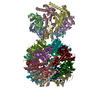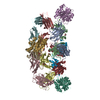+ Open data
Open data
- Basic information
Basic information
| Entry | Database: PDB / ID: 6riq | |||||||||
|---|---|---|---|---|---|---|---|---|---|---|
| Title | MinCD filament from Pseudomonas aeruginosa | |||||||||
 Components Components |
| |||||||||
 Keywords Keywords | PROTEIN FIBRIL / Bacterial cell division | |||||||||
| Function / homology |  Function and homology information Function and homology informationregulation of cell septum assembly / negative regulation of cell division / division septum assembly / cell morphogenesis / cytoplasmic side of plasma membrane /  cell division / cell division /  ATP hydrolysis activity / ATP hydrolysis activity /  ATP binding / ATP binding /  plasma membrane / plasma membrane /  cytosol cytosolSimilarity search - Function | |||||||||
| Biological species |   Pseudomonas aeruginosa (bacteria) Pseudomonas aeruginosa (bacteria) | |||||||||
| Method |  ELECTRON MICROSCOPY / helical reconstruction / ELECTRON MICROSCOPY / helical reconstruction /  cryo EM / Resolution: 3.1 Å cryo EM / Resolution: 3.1 Å | |||||||||
 Authors Authors | Szewczak-Harris, A. / Wagstaff, J. / Lowe, J. | |||||||||
| Funding support |  United Kingdom, 2items United Kingdom, 2items
| |||||||||
 Citation Citation |  Journal: FEBS Lett / Year: 2019 Journal: FEBS Lett / Year: 2019Title: Cryo-EM structure of the MinCD copolymeric filament from Pseudomonas aeruginosa at 3.1 Å resolution. Authors: Andrzej Szewczak-Harris / James Wagstaff / Jan Löwe /  Abstract: Positioning of the division site in many bacterial species relies on the MinCDE system, which prevents the cytokinetic Z-ring from assembling anywhere but the mid-cell, through an oscillatory ...Positioning of the division site in many bacterial species relies on the MinCDE system, which prevents the cytokinetic Z-ring from assembling anywhere but the mid-cell, through an oscillatory diffusion-reaction mechanism. MinD dimers bind to membranes and, via their partner MinC, inhibit the polymerization of cell division protein FtsZ into the Z-ring. MinC and MinD form polymeric assemblies in solution and on cell membranes. Here, we report the high-resolution cryo-EM structure of the copolymeric filaments of Pseudomonas aeruginosa MinCD. The filaments consist of three protofilaments made of alternating MinC and MinD dimers. The MinCD protofilaments are almost completely straight and assemble as single protofilaments on lipid membranes, which we also visualized by cryo-EM. | |||||||||
| History |
|
- Structure visualization
Structure visualization
| Movie |
 Movie viewer Movie viewer |
|---|---|
| Structure viewer | Molecule:  Molmil Molmil Jmol/JSmol Jmol/JSmol |
- Downloads & links
Downloads & links
- Download
Download
| PDBx/mmCIF format |  6riq.cif.gz 6riq.cif.gz | 739.6 KB | Display |  PDBx/mmCIF format PDBx/mmCIF format |
|---|---|---|---|---|
| PDB format |  pdb6riq.ent.gz pdb6riq.ent.gz | 627.4 KB | Display |  PDB format PDB format |
| PDBx/mmJSON format |  6riq.json.gz 6riq.json.gz | Tree view |  PDBx/mmJSON format PDBx/mmJSON format | |
| Others |  Other downloads Other downloads |
-Validation report
| Arichive directory |  https://data.pdbj.org/pub/pdb/validation_reports/ri/6riq https://data.pdbj.org/pub/pdb/validation_reports/ri/6riq ftp://data.pdbj.org/pub/pdb/validation_reports/ri/6riq ftp://data.pdbj.org/pub/pdb/validation_reports/ri/6riq | HTTPS FTP |
|---|
-Related structure data
| Related structure data |  4897MC M: map data used to model this data C: citing same article ( |
|---|---|
| Similar structure data |
- Links
Links
- Assembly
Assembly
| Deposited unit | 
|
|---|---|
| 1 |
|
- Components
Components
| #1: Protein | Mass: 15107.273 Da / Num. of mol.: 11 Source method: isolated from a genetically manipulated source Source: (gene. exp.)   Pseudomonas aeruginosa (bacteria) / Production host: Pseudomonas aeruginosa (bacteria) / Production host:   Escherichia coli (E. coli) / References: UniProt: A0A2R4B4N7, UniProt: Q9HYZ7*PLUS Escherichia coli (E. coli) / References: UniProt: A0A2R4B4N7, UniProt: Q9HYZ7*PLUS#2: Protein | Mass: 29705.143 Da / Num. of mol.: 11 Source method: isolated from a genetically manipulated source Source: (gene. exp.)   Pseudomonas aeruginosa (bacteria) Pseudomonas aeruginosa (bacteria)Gene: minD, minD_2, ALP65_02808, C0044_24365, C8257_09550, CAZ10_22480, CGU42_07990, DZ940_07140, DZ962_16115, EFK68_22340, EGV95_09885, EGY23_16190, IPC1135_03845, NCTC13719_01733, PAERUG_E15_London_ ...Gene: minD, minD_2, ALP65_02808, C0044_24365, C8257_09550, CAZ10_22480, CGU42_07990, DZ940_07140, DZ962_16115, EFK68_22340, EGV95_09885, EGY23_16190, IPC1135_03845, NCTC13719_01733, PAERUG_E15_London_28_01_14_02879, RW109_RW109_02577 Production host:   Escherichia coli (E. coli) / References: UniProt: A0A071KWM5, UniProt: Q9HYZ6*PLUS Escherichia coli (E. coli) / References: UniProt: A0A071KWM5, UniProt: Q9HYZ6*PLUS#3: Chemical | ChemComp-MG / #4: Chemical | ChemComp-ATP /  Adenosine triphosphate Adenosine triphosphate |
|---|
-Experimental details
-Experiment
| Experiment | Method:  ELECTRON MICROSCOPY ELECTRON MICROSCOPY |
|---|---|
| EM experiment | Aggregation state: HELICAL ARRAY / 3D reconstruction method: helical reconstruction |
- Sample preparation
Sample preparation
| Component | Name: MinCD Filament / Type: COMPLEX / Entity ID: #1-#2 / Source: RECOMBINANT |
|---|---|
| Source (natural) | Organism:   Pseudomonas aeruginosa (bacteria) Pseudomonas aeruginosa (bacteria) |
| Source (recombinant) | Organism:   Escherichia coli (E. coli) Escherichia coli (E. coli) |
| Buffer solution | pH: 7 |
| Specimen | Embedding applied: NO / Shadowing applied: NO / Staining applied : NO / Vitrification applied : NO / Vitrification applied : YES : YES |
Vitrification | Instrument: FEI VITROBOT MARK IV / Cryogen name: ETHANE |
- Electron microscopy imaging
Electron microscopy imaging
| Experimental equipment |  Model: Tecnai Polara / Image courtesy: FEI Company |
|---|---|
| Microscopy | Model: FEI POLARA 300 |
| Electron gun | Electron source : :  FIELD EMISSION GUN / Accelerating voltage: 300 kV / Illumination mode: FLOOD BEAM FIELD EMISSION GUN / Accelerating voltage: 300 kV / Illumination mode: FLOOD BEAM |
| Electron lens | Mode: BRIGHT FIELD Bright-field microscopy Bright-field microscopy |
| Specimen holder | Cryogen: NITROGEN |
| Image recording | Electron dose: 38 e/Å2 / Detector mode: INTEGRATING / Film or detector model: FEI FALCON III (4k x 4k) / Num. of real images: 3050 |
- Processing
Processing
CTF correction | Type: PHASE FLIPPING AND AMPLITUDE CORRECTION |
|---|---|
| Helical symmerty | Angular rotation/subunit: 116.265 ° / Axial rise/subunit: 24.998 Å / Axial symmetry: C1 |
3D reconstruction | Resolution: 3.1 Å / Resolution method: FSC 0.143 CUT-OFF / Num. of particles: 118659 / Symmetry type: HELICAL |
| Atomic model building | Protocol: AB INITIO MODEL / Space: RECIPROCAL |
 Movie
Movie Controller
Controller









 PDBj
PDBj



